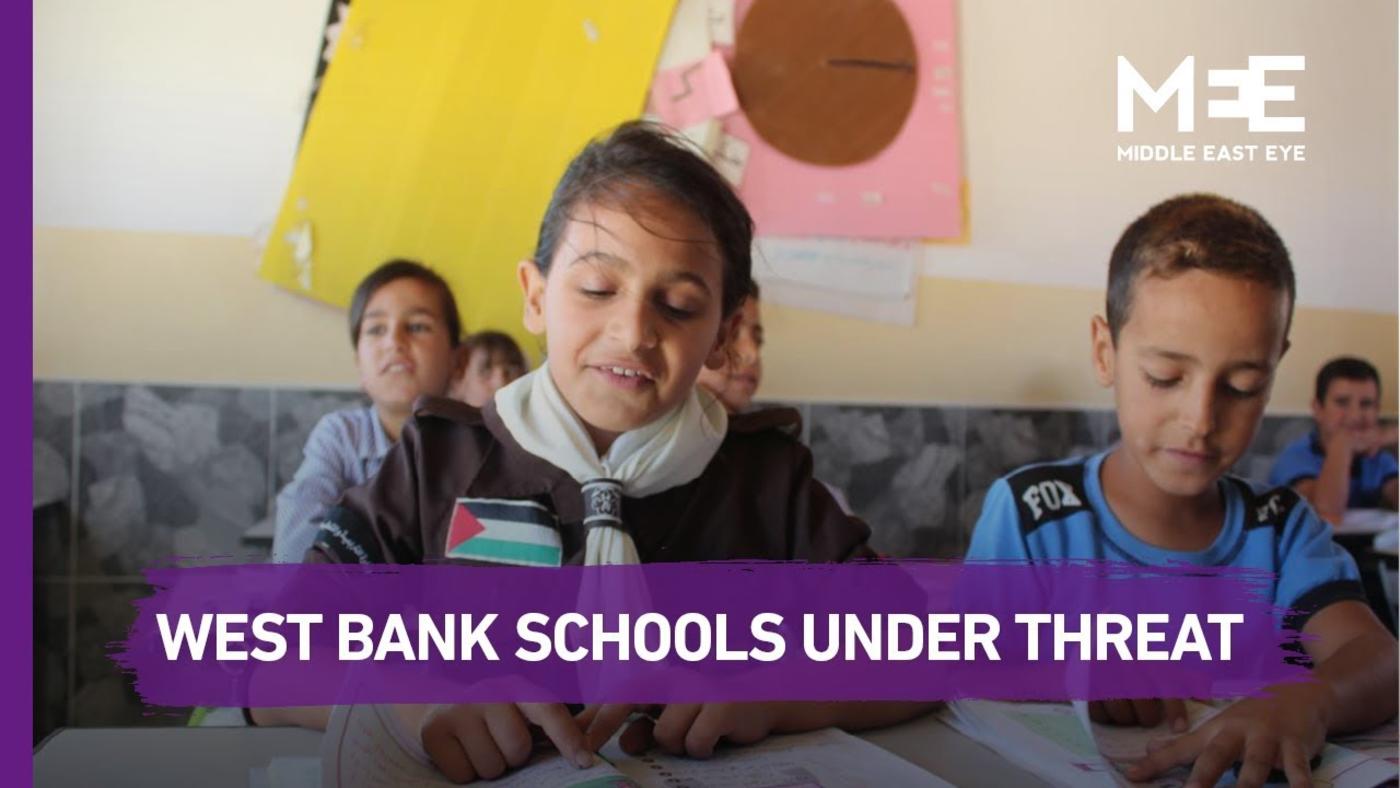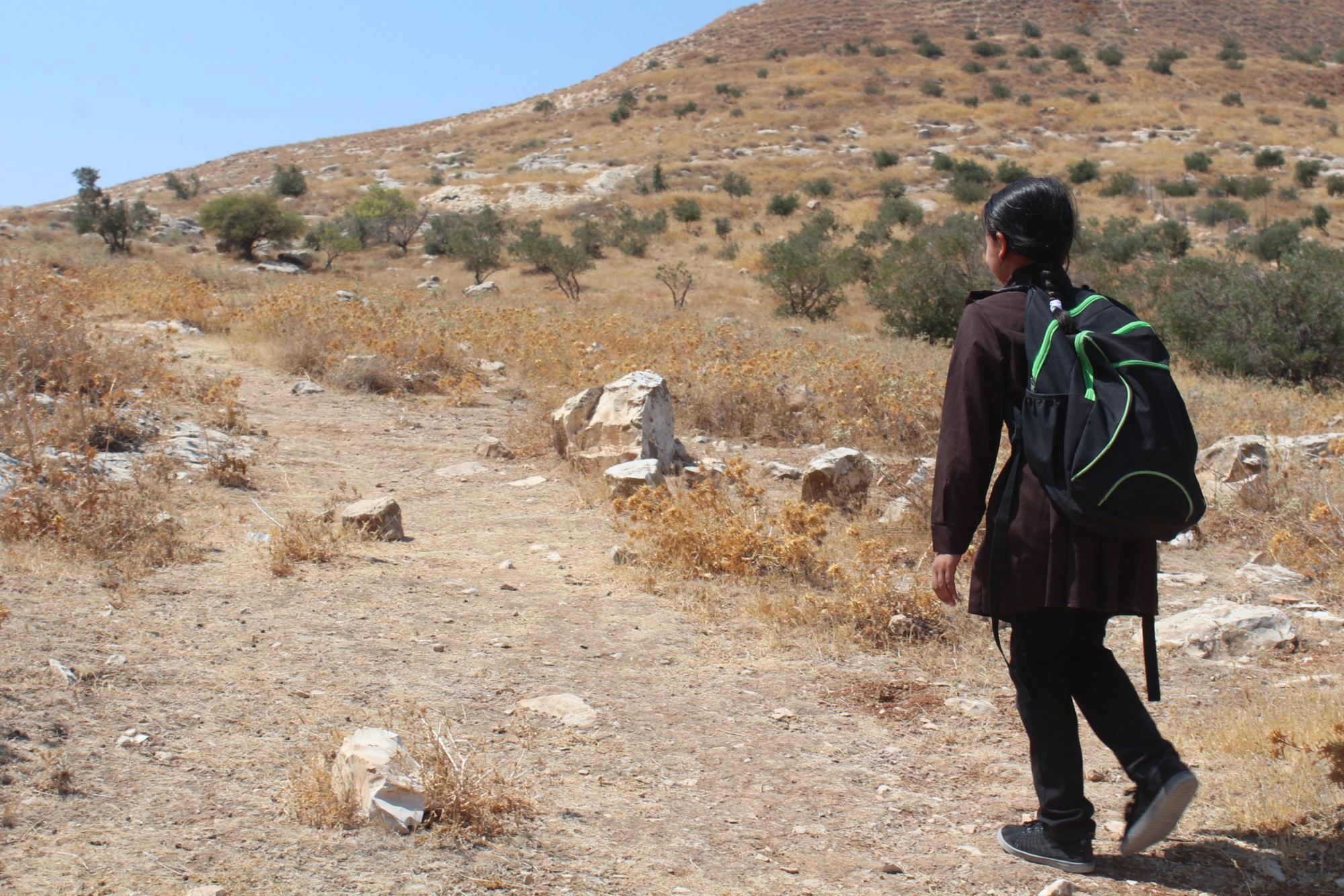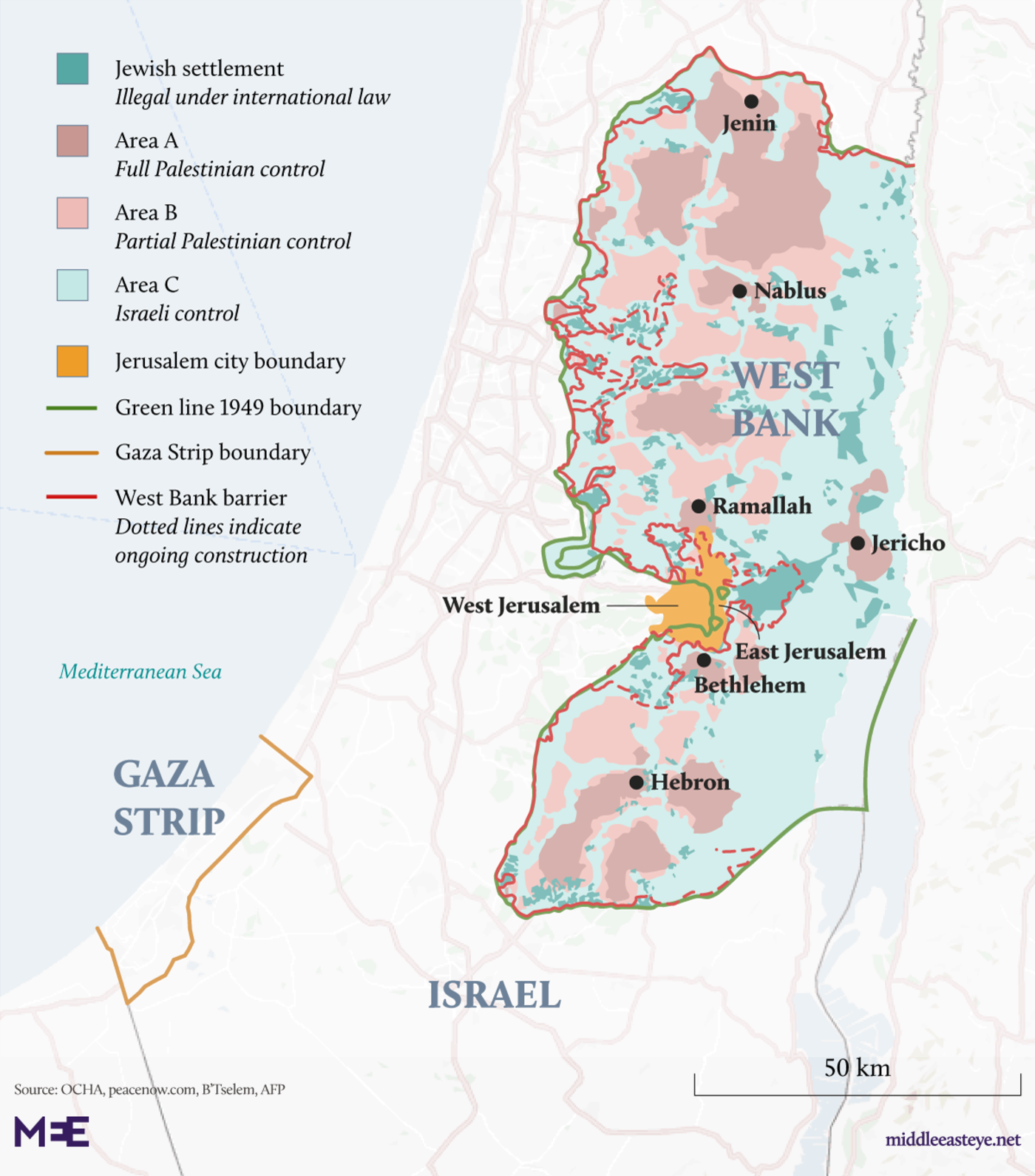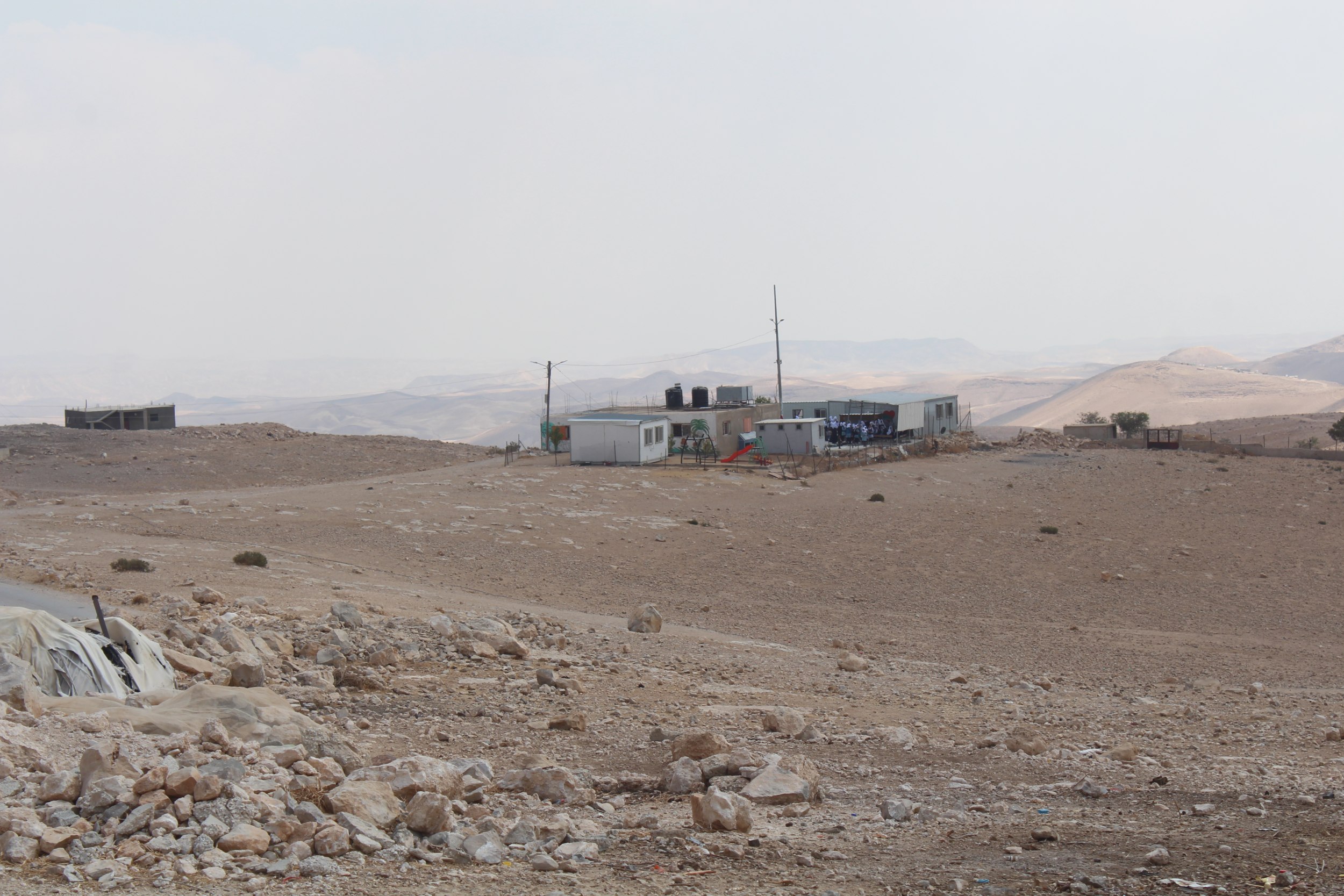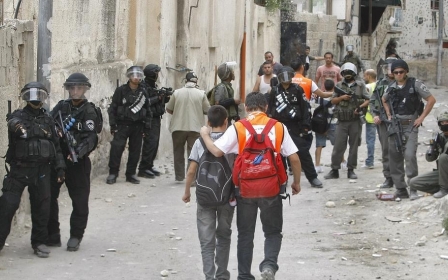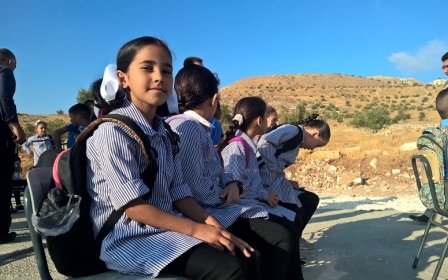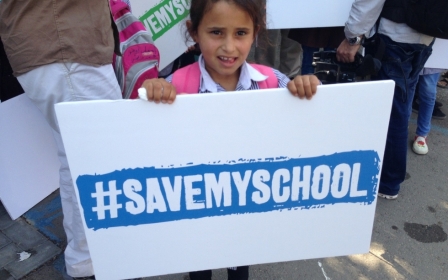Bullets, demolitions and dreams: West Bank education under threat
At 7:45 am sharp, 41 Palestinian children swiftly form neat lines in front of their school to perform the morning scout band routine. Leading the young students is their peer Ibtisam al-Wahsh, who proudly carries her band’s flag high as she sings the national anthem.
The children, aged between six and nine years old, echo her words loudly, their eyes directed at the Palestinian flag hanging from one of the school’s windows.
Situated between the small villages of Jubbet al-Dhib and Beit Taamir in the southern occupied West Bank governorate of Bethlehem, Al-Tahadi School 5 is - once again - under threat of demolition by Israeli forces.
Severely underfunded, the school has no walls to surround it, no front gate or even umbrellas or a canopy to shade the children from the heat of the sun or the winter rain. The playground consists of dirt and gravel, and there are no toys for the children to play with.
New MEE newsletter: Jerusalem Dispatch
Sign up to get the latest insights and analysis on Israel-Palestine, alongside Turkey Unpacked and other MEE newsletters
Ibtisam makes the daily journey to school on a dirt road strewn with rocks and prickly shrubs. The eight-year-old says she wants to become a doctor or an Arabic language teacher.
Despite being torn between the two, she tells Middle East Eye that she is leaning towards the latter. “I want to return to my school and become a teacher so that I can prevent the Israeli army from demolishing it.”
School 5 is one of 17 Tahadi schools - named after the Arabic word for “challenge” - in Area C, the 60 percent of the occupied West Bank that lies under full Israeli military and administrative control, where Israel severely restricts Palestinian development and promotes Jewish-only settlements deemed illegal under international law.
All 17 schools were built by the Palestinian Authority (PA) - many with European Union funding - and are at high risk of being demolished by the Israeli army.
The PA Ministry of Education began building the schools in 2016 to provide education to otherwise marginalised rural communities dispersed throughout the West Bank. Some of the schools are located in villages near “firing zones” declared by the Israeli army, leaving residents exposed to forced evacuations, stray bullets and unexploded ordnance during military exercises.
The ministry’s efforts are of “national importance”, it says, as an attempt to curb Israeli illegal settlement expansion and strengthen the presence of Palestinian communities on lands under threat of theft by Israel.
Minimal resources
Al-Tahadi School 5 stands on a hill on land donated by the al-Zawahra family who live nearby. The first day of school was meant to be 23 August 2017.
The night before, however, the Israeli army raided the area, confiscated the school’s equipment, and demolished the small rooms made of zinc sheets and concrete blocks. The children had their first day of school out in the open air.
“It was heartbreaking to see children and their teachers turning up for their first day of school under the blazing sun, with no classrooms or anywhere to seek shelter, while in the immediate vicinity work to expand illegal settlements goes on uninterrupted,” Norwegian Refugee Council policy manager Itay Epshtain said at the time.
‘The lead in your pencils is more powerful than the lead in their bullets’
- Amna Mousa, school principal
Two years later, school principal Amna Mousa tells MEE that the army demolished the school under the pretext that it was built in Area C without an Israeli-issued permit.
The Israeli army regularly carries out demolition orders against homes, schools - including kindergartens - and other properties in Area C.
While facilitating the expansion of settlements for the benefit of Israeli citizens, the army requires that Palestinians apply for almost impossible-to-obtain building permits, then proceeds to punitively demolish any structures that are constructed without one.
After the demolition of School 5, communities in the area subsequently decided to rebuild the school in September 2017.
“There is no alternative school for the children who live in the nearby community of Jubbet al-Dhib,” says Mousa, who worked as an English teacher for more than 20 years in several schools in Bethlehem. “Other schools are more than eight kilometres away.
“At this school we are leading the educational process with the most basic resources and capacity available,” she adds.
She explains that in recent years, she would closely follow the news of the Israeli army’s assaults on Tahadi School 5. “I would tell myself that if I became principal of the school, I would do my best to withstand the difficult conditions, and I began to plan how I would enhance the educational reality for the children.”
“The lead in your pencils is more powerful than the lead in their bullets,” Mousa consistently tells her students.
This is also what PA Minister of Education Sabri Saidam told the schoolchildren during a visit in November 2018 with a delegation from Unesco, which was targeted by Israeli forces who raided the area and began firing sound bombs and tear gas.
Ibrahim al-Wahsh, nine, says he will never forget that day.
“We are afraid of the army,” he tells MEE. “They don’t want us to grow up and learn. They come here and fire bullets and [sound] bombs at us… everyone starts crying.”
The looming threat of settler violence
In the area of Masafer Yatta, in the southernmost part of the West Bank known as the South Hebron Hills, the first al-Tahadi School was built in 2016 in the community of Irfaaiya.
Today, the school hosts 103 Palestinian students who in the past had been forced to travel long distances to obtain an education. The school stands on a 300 square-metre space and lies on a steep, dangerous slope near several cow farms. Just above lies a road built for nearby Israeli settlements.
The principal, Adel al-Jbour, tells MEE that Irfaaiya is the target of consistent assaults by Israeli settlers, stirring fear amongst students and teachers.
Anoud al-Amour says she and her classmates have been directly threatened by settlers.
“We’re very afraid when we cross the street. When the settlers see us from their cars, they start speeding towards us,” the young girl tells MEE. “They also take out their guns and aim them at us.”
‘We are afraid of the army. They don’t want us to grow up and learn’
- Ibrahim al-Wahsh, 9-year-old student
The 13-year-old dreams of her school growing in size, yet she fears imminent demolition. If her school is destroyed, she will have to attend one that is further away, meaning more threats to her safety.
“Our parents fear for us, they would even prefer us staying home rather than being exposed to the settlers,” she continues.
Assaults and attacks by settlers on Palestinian villages causing property damage and casualties have dramatically risen in recent years, as documented by the United Nations Office for the Coordination of Humanitarian Affairs (OCHA).
In 2018 alone, Israeli settlers killed three Palestinians and injured 83 others, including at least 20 children. The attacks came in various forms: shootings, car rammings, stone-throwing and arson attacks on homes and fields, to name a few.
“The Irfaaiya school is very important to us. It is one of the reasons we remain in this area despite all the threats by the army and settlers,” Mohammad Bassam al-Amour, 13, tells MEE.
He says he and his peers fear being kidnapped by settlers. “When they see us on our way to school, they stop and ask us to get in the car with them, so we run away,” he says. “They have their guns pointed at us, and when they are driving they try to run us over.”
‘We walk through valleys and hills to get to school’
The PA Ministry of Education believes that because of the impact of the Israeli occupation, responsibility for ensuring Palestinian children’s access to education falls in part on the international community.
Ministry spokesman Sadeq al-Khdour tells MEE there are currently 13 al-Tahadi schools in operation, with another four under construction. All of them, he says, are currently facing threats of demolition by the Israeli army, and some have already been demolished and rebuilt.
“There is always rhetoric around the world about a child’s right to education, but when it comes to a Palestinian child, the international community is quiet,” he says.
“What is required of international organisations is to carry out their roles, to be present on the field, to document the assaults by the Israeli army on schools on a daily basis and to put an end to them,” Khdour adds.
“We hope that these schools will persevere in the face of continued Israeli threats... We view them as centres of radiance, giving knowledge to the Palestinian Bedouin communities, which the Israeli occupation has for years deprived of its most basic rights - the right to education.”
The success of the first school in Irfaaiya paved the path for the rest of the al-Tahadi schools to emerge.
Al-Tahadi School 16 stands in the village of Zweideen in the area of Khashm al-Darj in the Hebron governorate. The all-girls high school provides an opportunity for teenage girls in the surrounding communities to continue their education, as many had been previously forced to drop out because of the absence of a school in the vicinity.
The school is small - 400 square metres - and consists of a number of small barracks and no playground.
“Each year the school grew by one or two classrooms,” Zweideen school headmistress Aminah Daajnah, tells MEE.
“The school today runs from the sixth grade to twelfth grade, with some 120 female students,” she says, adding that the school also has a kindergarten hosting 27 children.
Two kilometres away from the school lies the illegal settlement of Karmel. According to Daajnah, Israeli army patrols are consistently present in the area, leaving military debris which threatens the students’ lives.
“We dream of building a school with great facilities, like other schools around the world,” she says. “We began expanding and improving the school, but the Israeli army gave us a notice ordering us not to continue building, and threatened us with demolition.”
Samah Basaytah, 17, walks from her village on unpaved dirt roads to get to school - a journey that takes her about half an hour. In winter, she, like many of her peers, is forced to skip school.
“We walk through valleys and hills to get to school. When it starts raining heavily, it becomes even more difficult to attend class.”
Her dream, she says, is to have a school that is better equipped and can absorb a greater number of students. “The barracks become very hot in the summer and very cold in the winter, so we struggle to focus,” Basaytah says.
“Yet, despite all these hardships, if it weren’t for this school, I wouldn’t have been able to continue my studies and chase after my dreams.”
This article is available in French on Middle East Eye French edition.
Middle East Eye delivers independent and unrivalled coverage and analysis of the Middle East, North Africa and beyond. To learn more about republishing this content and the associated fees, please fill out this form. More about MEE can be found here.


